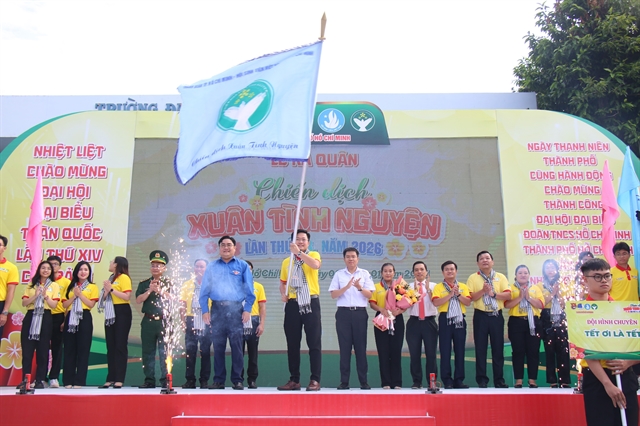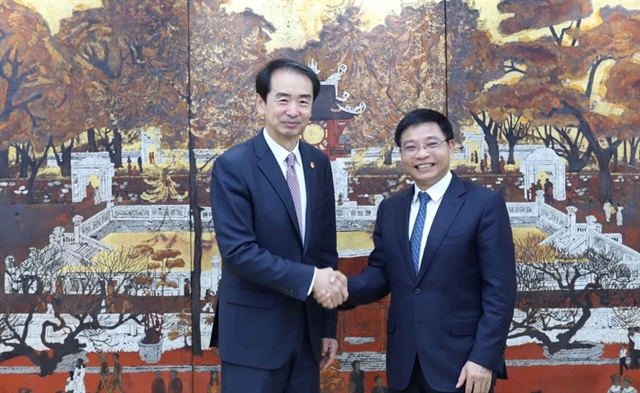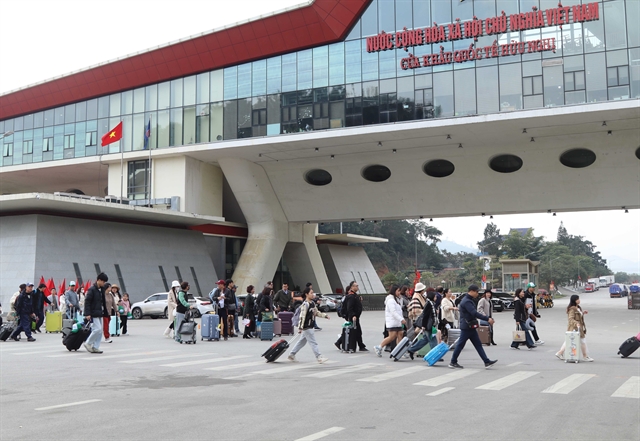 Politics & Law
Politics & Law
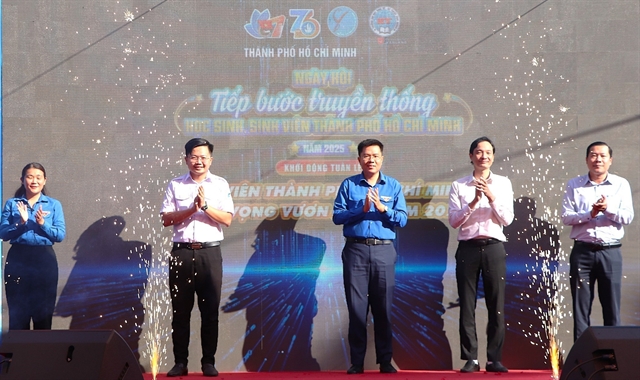
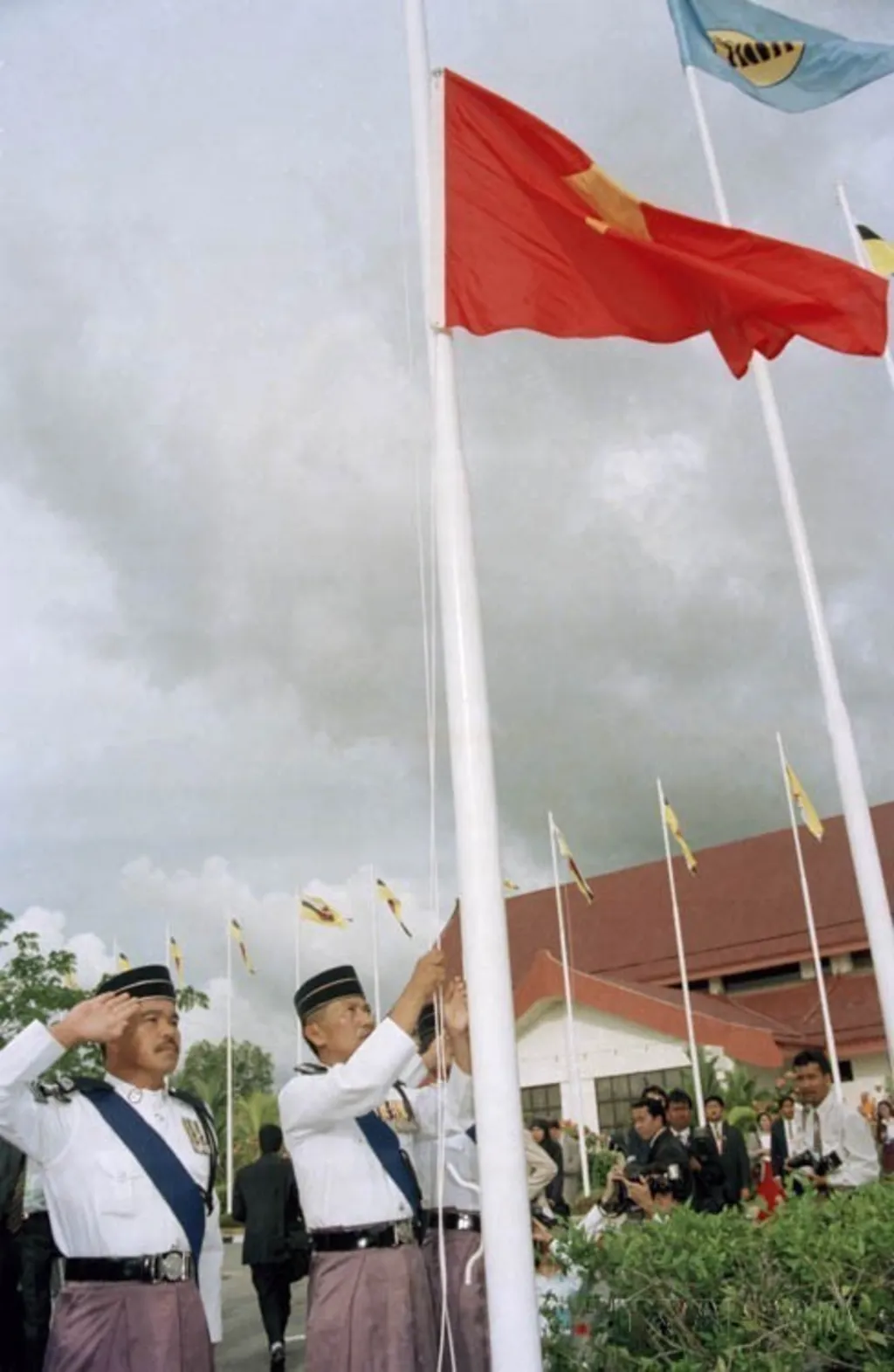 |
| Flag-raising ceremony during the event marking Việt Nam’s admission as the seventh member of ASEAN, held on July 28, 1995 in Brunei. VNA/VNS Photo Trần Sơn |
As Việt Nam commemorates three decades of membership in the Association of Southeast Asian Nations (ASEAN), the country finds itself in a markedly different position than when it first joined the bloc in 1995.
Once a diplomatically isolated state struggling under the weight of sanctions and blockades, Việt Nam now stands as a proactive regional actor with expansive global partnerships and a promising economic clout.
On July 28, 1995, in a ceremony in Bandar Seri Begawan, Brunei, the flag of the Socialist Republic of Việt Nam was hoisted for the first time prior to the 28th ASEAN Foreign Ministers Meeting, marking the country's accession as the bloc's seventh member.
Thirty years later, Việt Nam’s membership is widely seen as a turning point in its foreign policy – a strategic decision that helped pull the country out of Cold War isolation and embed it within a dynamic regional and global system.
"It was a hit-or-miss moment," said Nguyễn Vũ Tùng, a former Vietnamese ambassador to South Korea and president of the Diplomatic Academy of Việt Nam, during a commemorative meeting hosted by the ISEAS – Yusof Ishak Institute.
The decision to join ASEAN was about foreign policy but also about economic development model, because eventually the function of Việt Nam's foreign policy is to create favourable conditions for national development, Tùng said.
"At the time, there were visible success stories of East Asian economic miracles, including in Southeast Asia such as Singapore, Malaysia, Thailand, Indonesia, and the Philippines. Việt Nam just happened to be in that region where the miracles happened, so that's another consideration to join ASEAN," Tùng added.
By joining ASEAN, Việt Nam has accomplished its goal of having a peaceful and cooperative neighbouring environment for it to focus on economic development under the đổi mới (renewal) agenda, as well as enjoy new economic interests, especially in terms of trade, investment and tourism.
Việt Nam’s road to ASEAN was paved with profound structural shifts. The end of the Cold War, the dissolution of the Soviet bloc and the 1991 settlement of the Cambodian conflict opened a window for realignment.
As Carl Thayer, emeritus professor at the University of New South Wales Canberra and a veteran Việt Nam observer, told Việt Nam News: "In the late 1980s, Việt Nam assessed that the major threats to its security and independence were economic weakness, political isolation and embargo. The Politburo [of the Vietnam Communist Party] introduced the concept of national interest and called for 'more friends, fewer enemies'."
Việt Nam in 1991 then adopted the policy of diversifying and multilateralising its all-round relations with all countries.
That spirit of strategic recalibration culminated in Việt Nam’s decision to seek ASEAN membership. The formal accession came just over two weeks after normalisation of ties with the United States after a protracted blockade following the bitter war that the US waged in Việt Nam.
According to Andrew Wells-Dang, PhD, a senior specialist on Việt Nam–US relations, this is not a mere coincidence.
"These two steps extended đổi mới to foreign relations and laid the foundation for Việt Nam’s economic development and diversified foreign policy since then," Wells-Dang said.
Việt Nam's membership in ASEAN was supported by both China and the United States as a positive development contributing to peace and security in the region, Thayer said, adding that Việt Nam's membership in ASEAN enhanced its prestige and standing in the world.
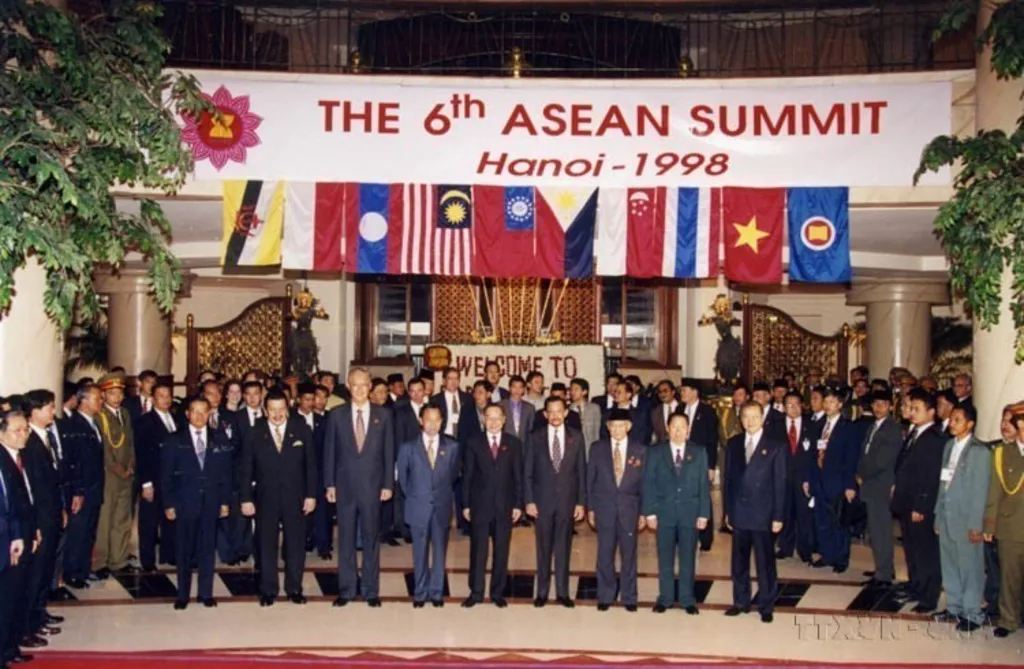 |
| In 1998, Việt Nam successfully organised the ASEAN Summit for the first time since joining the bloc three years earlier. VNA/VNS Photo Nguyễn Khang |
From outsider to insider
In its early ASEAN years, Việt Nam approached the bloc with a degree of caution. Hoàng Thị Hà, a former ASEAN Secretariat official and now a senior fellow at ISEAS, recalled that Hà Nội was among the most conservative voices within ASEAN.
"Việt Nam was a staunch guardian of traditional ASEAN principles, particularly consensus and non-interference. Having only just escaped Cold War divisions, it was highly wary of any external agendas," she said.
Economically, Việt Nam argued for a phased approach to integration and targeted support to narrow development gaps. As a more recent member, Việt Nam consistently supported ASEAN’s initiatives to close the development gap, which had been clearly demonstrated in the 2001 Hà Nội Declaration on Narrowing the Development Gap for Closer ASEAN Integration, which highlights a shared duty to help Cambodia, Laos, Myanmar, and Việt Nam fully participate in the ASEAN economic community.
Over time, Việt Nam's posture evolved from defensive to more proactive. Hà noted a significant shift as it gained economic confidence and diplomatic sophistication.
Việt Nam gradually transitioned to an outward-looking actor, aligning more with maritime ASEAN states like Singapore in the advocacy for an open, inclusive and rules-based regional order, as well as in a strong involvement of all major powers in ASEAN-led mechanisms, she said.
"ASEAN provided regular hands-on platforms for Vietnamese officials to unlearn Cold War rigid binary thinking of friend vs foes or scepticism towards ideologically different states, and to internalise regional norms, as well as international practices, standards and multilateral diplomacy and negotiation skills," Hà said. "Those were crucial experiences that shape the country's broader global integration."
Over the last three decades since the accession, Việt Nam has made at least four major contributions to ASEAN, Thayer said.
First, Việt Nam promoted the admission of Cambodia, Laos and Myanmar, thus meeting the original ASEAN goal of including all countries in Southeast Asia.
Second, when Việt Nam assumed the role of ASEAN Chair for the first time in 1998, the country had secured the endorsement of a six-year Hà Nội Plan of Action to implement ASEAN Vision 2020.
Third, when Việt Nam served as ASEAN Chair for the second time in 2010, it successfully expanded membership on the East Asia Forum to include the United States and Russia, and also hosted the inaugural ASEAN Defence Ministers' Meeting Plus – which is a platform for the bloc to engage with its dialogue partners to strengthen security and defence cooperation for peace, stability and development in the region.
Fourth, as ASEAN Chair for the third time in 2020, Việt Nam made an outstanding contribution to ASEAN’s development during the complex developments of the COVID-19 pandemic, Thayer said.
"Việt Nam pioneered virtual meetings of ASEAN officials and Việt Nam undertook a proactive role in lobbying the major powers for access to vaccines and the transfer of needed medical equipment," he said.
On the East Sea [internationally known as China Sea] issue, Việt Nam has walked a fine line. Hà Nội has sought to leverage ASEAN mechanisms to press for international legal norms while avoiding bloc fracture.
Việt Nam's 2020 ASEAN Chairmanship saw a carefully calibrated diplomatic gain: the bloc’s reaffirmation of the 1982 UN Convention on the Law of the Sea as the basis for maritime conduct.
"Việt Nam foregrounded the convention in all summit documents," Hà said, calling it a modest but meaningful diplomatic victory.
On Việt Nam's accession, Secretary-General of ASEAN Kao Kim Hourn has noted the 'transformative catalyst' for the grouping's ASEAN-10 vision, how the country's multi-directional foreign policy aligns and enriches outward-looking external relations, its staunch advocate for a network of free trade agreements, and how its sustained high economic growth has not just benefited Vietnamese people but also strengthened the whole region.
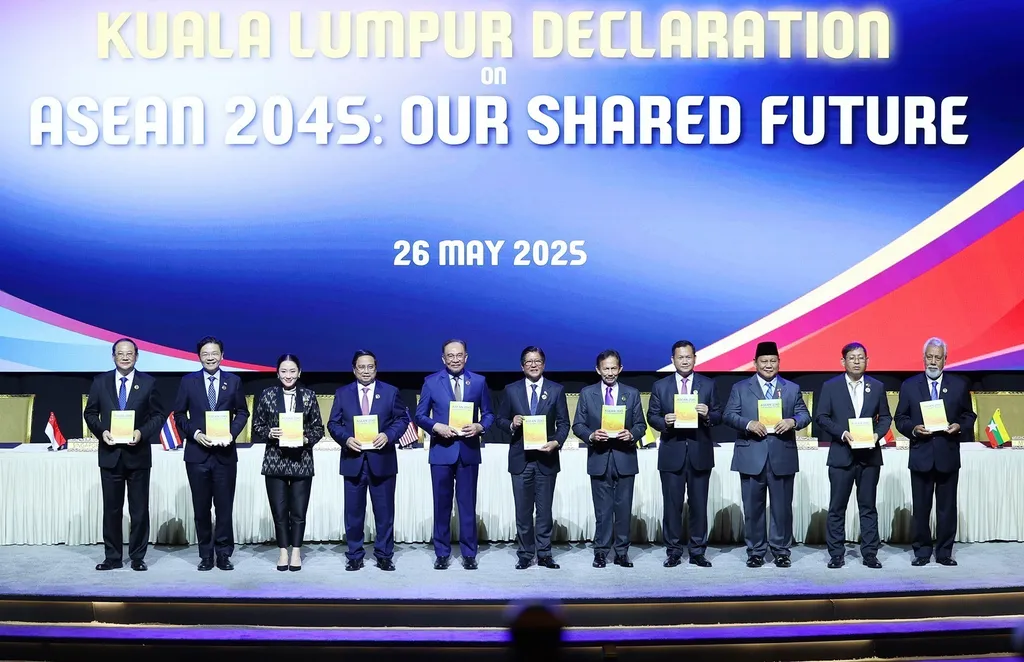 |
| Vietnamese Prime Minister Phạm Minh Chính (4th left) and other ASEAN leaders at the signing ceremony of the Kuala Lumpur Declaration on ASEAN 2045. VNA/VNS Photo Dương Giang |
Today, Việt Nam is proud of its 30-year journey of international integration, with ASEAN serving as a starting point and gateway to broader regional and global engagement. The country has now established diplomatic relations with 194 states and actively participates in over 70 international and regional bodies, and entered free trade agreements with over 60 countries and economies.
ASEAN remains a pillar of Việt Nam's foreign policy, though not the sole one.
"Việt Nam views ASEAN as one pillar of a multi-polar strategy," said Dr Wells-Dang. "Its importance has not always reached its potential, partly due to differences among ASEAN members on issues like the East Sea or Mekong water governance."
Still, ASEAN provides a vital anchor for Việt Nam's regional identity.
"Việt Nam is now seen as a pivot country," he said. "It may not be the leading face of ASEAN, but its role has steadily increased. It's impossible to imagine the bloc without Việt Nam."
Surveys bear this out. In the 2024 and 2025 reports by the ASEAN Studies Centre at the ISEAS - Yusof Ishak Institute, Việt Nam ranked fifth in the region in terms of contributing to ASEAN’s long-term development, behind Singapore, Indonesia, Malaysia, and Thailand.
Facing the future
As ASEAN enters a period of institutional introspection amid great-power rivalry, the bloc faces pressure to adapt.
Wells-Dang said that the ASEAN's governing principles include respect for members' sovereignty and non-interference in internal affairs.
"While sovereignty is unquestionable, the non-interference principle has weakened ASEAN's ability to resolve conflicts within and among member states," Wells-Dang said.
"How can Việt Nam and Singapore, for instance, take a more active role in addressing the civil war in Myanmar, tensions between Cambodia and Thailand, or flashpoints in the East Sea?
"As the United States and other major powers take a more isolationist posture, or are preoccupied with their own domestic and regional challenges, there is potential for ASEAN to become more than a regional talking shop and become central to promoting peace and stability in Southeast Asia."
For now, the legacy of Việt Nam's 1995 decision is clear. What began as a bold gamble amid economic crisis has matured into one of Southeast Asia’s most significant post-Cold War foreign policy realignments. In ASEAN, Việt Nam found both a platform and a community.
As said by General Secretary Tô Lâm of the Việt Nam Communist Party when he gave a policy speech at the ASEAN Secretariat in March, since "embarking on our open-door policy and integration journey, ASEAN has served as the premier multilateral mechanism most directly connected with Việt Nam".
And looking forward, he said that Việt Nam's foreign policy focus would remain on collaborating with ASEAN to cultivate a dynamic and united community that advances peace, stability and prosperity in the region, "especially with a sense of self-responsibility for a more proactive role and greater contributions to the bloc via the guiding principle of being creative in thought, innovative in approach, flexible in delivery, effective in method and decisive in action". VNS
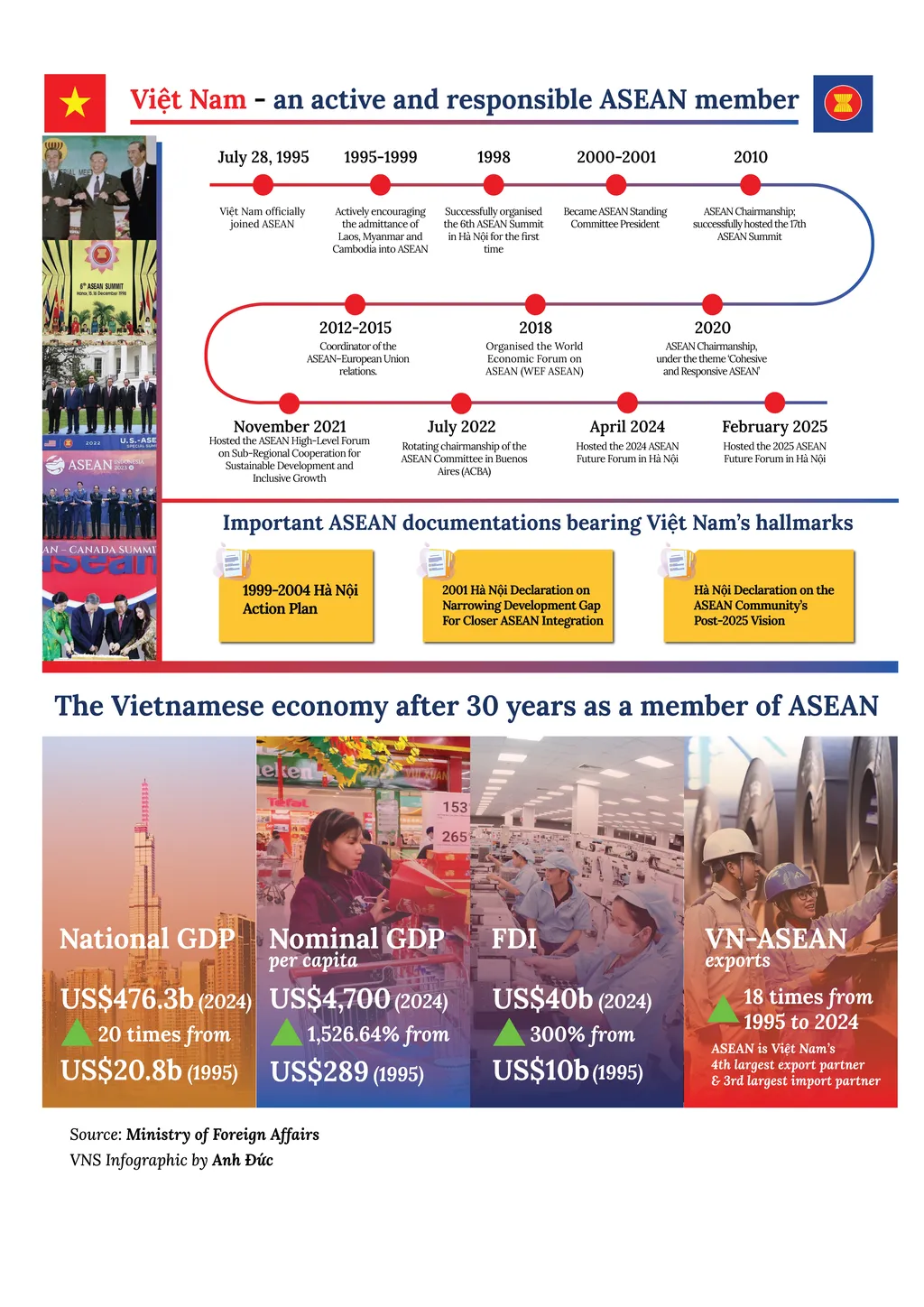 |


